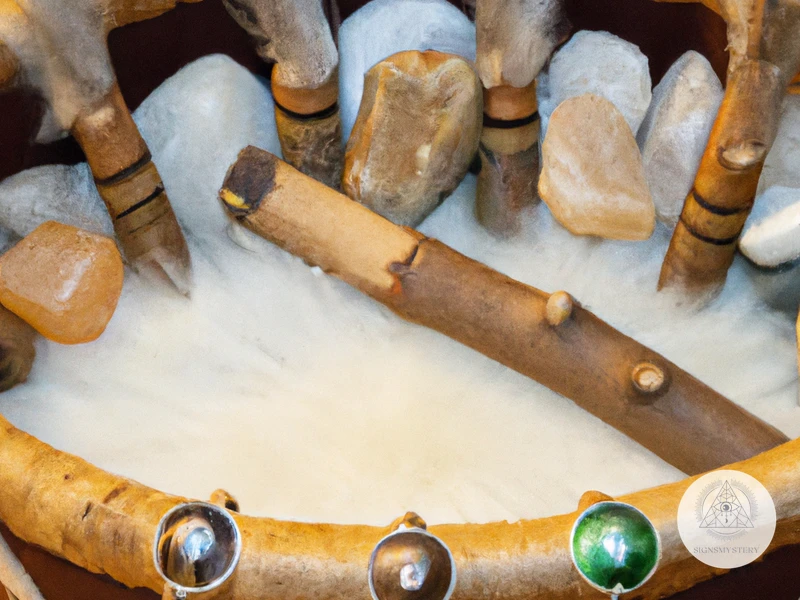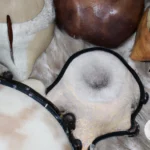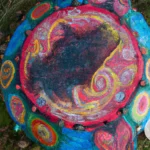As we delve into the enchanting world of Siberian shamanism, we uncover a rich culture of spiritual practices and beliefs, deeply rooted in the ancient ways of the land. Central to this awe-inspiring tradition are the shamanic tools and instruments, which carry a profound symbolism and function as gateways to other realms. From the evocative beat of the drum to the delicate sound of the flute, each instrument holds a unique meaning and purpose, offering a glimpse into the mystical world of the Siberian shaman. Join us as we explore the significance of these sacred tools and uncover the secrets of their usage in shamanic rituals, journeying, divination, and healing.
The Siberian Shamanism- A Brief Overview
Siberian Shamanism is one of the oldest spiritual practices that originated in Siberia, Russia. This shamanism is predominantly based on the belief that there are spirits residing in all natural elements- water, fire, wind, earth, trees, and animals. The term shamanism has been coined from the word ‘shamans,’ which denotes the priests and priestesses who are believed to communicate with the spirits. The belief system of Siberian shamanism is unique and is different from other shamanism practices. It emphasizes the importance of aiding others through healing, divination, and performing rituals. Traditionally, shamanism has played a crucial role in society, especially in the Northern regions of Siberia. Today, Siberian shamanism is still practiced in some areas, and it is important to explore this age-old tradition.
The Significance of Siberian Shamanic Tools and Instruments
In Siberian Shamanism, tools and instruments hold immense significance as they aid in various shamanic practices. According to Siberian shamanic beliefs, these tools and instruments are not just inanimate objects but are infused with spiritual energy and power of their own. Shamans have a personal connection with their tools and believe that they help them communicate and connect with the spiritual realm. Each tool or instrument has a specific meaning and usage, and they work together to help shaman achieve their desired outcome in a shamanic practice.
The use of drums in Siberian shamanic practices is closely associated with the heartbeat of the universe, and when shamans play them, it is believed that they are in tune with the cosmic rhythm. The flute is another instrument that is used to call spirits and helps the shamans alter their state of consciousness. The staff and wand are symbolic of the power that shamans hold, and they use them to maintain control during rituals.
The use of smudging tools is common in Siberian shamanic practices as they aid shamans in clearing negative energy from a person or a place. Mirrors are believed to be gateways to other realms, and shamans utilize them to communicate with the spiritual world. Similarly, bells are signifiers of sacred spaces, and their sound is believed to ward off negative energy. Amulets and Talismans are used by shamans to protect themselves and their clients from negative forces.
In addition to these tools, animal parts are also significant in Siberian shamanism. They are believed to be messengers from the divine and help the shamans in connecting with animals’ spiritual energy. Crystals are considered amplifiers of energy, and shamans use them to balance energy or increase its strength as required.
These tools and instruments play an essential role in the practice of Siberian shamanism. They are chosen, consecrated, and used according to shamanic rituals to perform specific tasks. These tools are symbolic of the shaman’s power and ability to communicate with the spiritual world.
Siberian Shamanic Tools and their Meanings

Siberian shamanic tools and instruments have been an essential aspect of the culture of Siberian shamanism for centuries. Each tool has a unique meaning and significance within the shamanic practice. The drum is considered to be the heartbeat of the shaman, the flute is used to call the spirits, the staff and wand are symbols of power, while smudging tools are used for clearing negative energy. Mirrors are considered as portals to other realms, while bells are signifiers of sacred spaces. Amulets, talismans, and animal parts are used for protecting the shaman and their clients. Lastly, crystals act as amplifiers of energy. The meanings behind these tools are an integral part of Siberian shamanism, and learning to use them properly is essential for any practitioner. If you want to learn more about the culture of Siberian shamanism, you can read about it in the Siberian Shamanism Introduction.
The Drum – Heartbeat of Siberian Shamans
The drum holds a special place in Siberian shamanic traditions as it is considered the heartbeat of the shaman. This tool is believed to be used for connecting with the spiritual realm and the various spirits that inhabit the universe. Shamans often use a drum made of a wooden frame and a stretched animal hide facing down.
The drum’s sound is associated with primal forces and spiritual powers. With each beat, the shaman is able to enter into a trance-like state, transported to the spiritual realm. The deep sound of the drum is also believed to summon spirits and deities, making it an important tool in shamanic rituals, especially during ceremonies that invoke the spirits of ancestors.
Shamanic drumming sessions typically last between 15 and 60 minutes. During drumming sessions, shamans may combine the drum with other instruments, such as rattles or flutes, in order to achieve a deeper level of spiritual connection.
The drum is typically decorated with symbols and designs that hold a special meaning in the shamanic tradition. These symbols can be used by the shaman to focus their intention and meditate on the spirits they are trying to summon.
One unique feature of Siberian shamanic drums is that they are often adorned with metal discs or jingles. These jingles are believed to enhance the drum’s power and vibration, making it easier for the shaman to enter into a trance-like state.
The drum is a powerful tool that holds immense significance in Siberian shamanic traditions. Its ability to transport and connect shamans to the spiritual realm makes it a vital instrument in shamanic rituals. The drum’s unique sound and design exemplify the rich culture of Siberian shamanism.
The Flute – Calling the Spirits
The flute is an essential tool in Siberian shamanism. Its sound is believed to call forth the spirits and bring them to the shaman. The flute is carved from wood and decorated with intricate designs that hold symbolic meanings. The shaman plays the instrument in a specific manner to create a particular rhythm and sound that resonates with the spirit world.
It is said that the flute’s sound can bring joy to the spirits, which encourages them to attend to the shaman’s calling. The melodies played on the flute can also have a calming effect on the shaman’s clients, helping them to relax and open themselves to the healing energies of the spirits.
The importance of the flute in Siberian shamanism can be seen in how it is used during shamanic rituals, such as the shamanic journey. The shaman uses the flute to create a meditative state that facilitates the journey into the spirit realm. The flute’s melodies guide the shaman on their journey and help to establish a connection with the spirits.
Interestingly, the flute is not always seen as a tool for calling forth spirits. In certain Siberian shamanic traditions, the flute is used instead to mimic the sounds of animals. This is believed to attract the spirit of the animal being represented, which can then be communicated with by the shaman.
The flute is a vital tool in Siberian shamanism, used for centuries to call forth the spirits and connect with the spirit world. Its importance is undeniable, and it remains an essential part of shamanic rituals and practices to this day.
Staff and Wand – Symbols of Power
In Siberian shamanism, the staff and wand are important tools used by the shaman during rituals and healing practices. The staff is a long, sturdy stick made from wood, while the wand is a shorter, more slender version. These tools are seen as symbols of power for the shaman, as they represent their ability to connect with spirits and manipulate the unseen forces of the universe.
The staff and wand are often decorated with feathers, fur, and other materials that hold spiritual significance in Siberian shamanic beliefs. The shaman will use the staff to draw power from the earth and channel it during their practices, while the wand is used for more delicate work, such as directing energy towards specific areas of the body during healing sessions.
In some cases, the staff and wand may be carved with intricate designs that hold deeper symbolic meanings. For example, a staff carved with a snake may represent the shaman’s ability to transform and shed their old skin, while a wand with a bear symbol may signify the shaman’s strength and courage.
It is important to note that the staff and wand are not just used for show, but are powerful tools that aid the shaman in their work. Through their use, the shaman is able to establish a deeper connection with the spirits and natural world around them, and tap into the collective unconscious to receive guidance and insight.
The staff and wand are integral to the practice of Siberian shamanism, serving as symbols of power for the shaman and aiding them in channeling energy during rituals and healing practices. Through their use, the shaman is able to establish a deeper connection with the spiritual realm and manipulate the unseen forces of the universe. For more information on Siberian shamanism, check out our article on Siberian Shamanism.
Smudging Tools – Clearing Negative Energy
In Siberian shamanism, smudging tools are used to clear negative energy from a space or person. Negative energy can create obstacles in a person’s physical, emotional, and spiritual health, impeding their progress. Smudging is a technique that uses smoke from burning herbs to purify and cleanse a space. It’s akin to an energetic bath that removes negative thoughts and emotions clinging to the aura.
Siberian shamans use a variety of herbs to make smudging sticks, including sage, sweetgrass, juniper, cedar, and mugwort. Each herb has unique properties that help to cleanse, heal, balance, and protect. For example, sage is known for its purifying and grounding properties, while sweetgrass is often used to bring in positive energy.
The most commonly used smudging tool is the smudge stick or smudge bundle, made by tying together a bundle of dried herbs. The stick is lit until it smolders, and the smoke is wafted over the body or around the space using a feather or fan. The smoke is regarded as a spiritual messenger carrying prayers and intentions to the divine.
Other smudging tools include abalone shells, which serve as a container for burning the herbs, and palo santo wood, which produces a sweet, fragrant smoke that is said to have healing properties. These tools are often used in combination with each other to enhance the smudging ritual’s effectiveness.
Overall, smudging tools are an essential part of Siberian shamanic practice, used to clear negative energy and promote healing and balance. Whether performing personal rituals or helping others, Siberian shamans use smudging tools to maintain spiritual and energetic hygiene.
If you’re curious about learning more about the Siberian shamanic tradition, you can read our article Comparing Siberian Shamanism: From Reindeer to Nature Spirits. You can also explore how Siberian shamans utilize healing techniques or learn about the importance of nature spirits in Siberian shamanic belief.
Mirrors – Gateways to Other Realms
The ancient Siberian shamans used mirrors as a tool for spiritual journeying. They believed that mirrors reflect not only the physical world but also the invisible realm of spirits. The shamans would gaze into the mirror and use it as a portal to communicate with the spirits of the other world.
Mirrors were also used as a means of protection. It was believed that spirits could become trapped in mirrors and, if necessary, shamans could trap negative entities in mirrors to protect themselves and those around them. Some mirrors had protective symbols etched into them or were made of specific materials, such as obsidian or silver, to enhance their powers.
In Siberian shamanism, mirrors were often used during healing rituals. The shaman would use the mirror to see into the client’s body or energy field and diagnose the problem. Mirrors were also used to reflect negative energy away from the client during the ritual.
Shamans believed that mirrors could provide a two-way passage to the spirit world. They used them not only to communicate with spirits but also to allow those spirits to enter our world. Some shamanic traditions even include the practice of “mirror walking,” or physically stepping through a mirror to enter other dimensions.
Mirrors were an essential tool of the Siberian shamanic practice, used for protection, divination, and communication with the spirit realm.
Internal link: Reindeer in Siberian Shamanism
Bells – Signifiers of Sacred Spaces
Bells have a special significance in Siberian shamanism as they are considered to be among the most powerful tools used by Siberian shamans. For Siberian shamans, bells are like voice-based tools that help them communicate with the spirits and entities of the spirit world.
In Siberian shamanic culture, bells are believed to have the power to cleanse and sanctify spaces. Shamans use bells to create protective boundaries around their working space. The sound from the bells is said to cleanse a space of negative energy. It is believed that the ringing of bells also helps to attract spiritual beings to the shaman’s working space.
Bells in Siberian shamanism come in different shapes and sizes. The materials used to make these bells vary from animal hide to metal. The most common type of bell used by Siberian shamans is made from iron or bronze and is usually shaped like a cone or round.
Siberian shamans use bells in their ceremonies and rituals. The bell is rung before the start of a ceremony to signal the beginning of a sacred space. The bell is also used to signal the end of a ceremony.
The sound of the bell is used to mark a transition from one stage of a ritual to the next. The bell can also be used in combination with other shamanic tools such as drums, rattles, and chanting to create a heightened spiritual experience.
Bells play a significant role in Siberian shamanic culture. They are powerful tools that are used to sanctify spaces and communicate with spiritual beings. Bells are essential signifiers of sacred spaces and their sounds create a powerful ambiance for shamanic rituals and ceremonies. If you want to know more about how Siberian shamanism has influenced the modern world, you can read our article on Siberian Shamanism in Modern Times.
Amulets and Talismans – Protecting the Shaman and their Clients
Amulets and talismans are important tools in the shamanic practice of the Siberian peoples. These items are believed to have protective qualities that can keep both the shaman and their clients safe from harm. There are various types of amulets and talismans in Siberian shamanism, each with their own unique meaning and purpose.
One common type of amulet is the bear tooth. The bear is a powerful symbol in Siberian shamanism, representing strength and courage. Bear teeth are believed to possess the qualities of the animal itself, making them effective at warding off negative energies and protecting the wearer.
Another popular amulet is the reindeer antler, which is often used as a symbol of spiritual growth and connection to the spirit world. The antlers are believed to help the shaman navigate the spirit realm and communicate with the spirits.
Horsehair bracelets or necklaces are also commonly used as talismans in Siberian shamanism. The hair from the mane or tail of a horse is believed to possess protective qualities, and the bracelets or necklaces made from them are worn to ward off negative energies and protect the wearer.
In addition to these traditional amulets and talismans, shamanic practitioners may also create their own personalized items for protection. These could include intricate beaded jewelry, carved wooden figurines, or other objects imbued with spiritual significance.
It is important to note that the use of amulets and talismans is not meant to replace other protective measures, such as physical barriers or personal safety precautions. Rather, they are an additional tool that can be incorporated into the shaman’s practice to help create a protected and sacred space for both the shaman and their clients.
Animal Parts – Messengers from the Divine
In Siberian shamanic practices, the use of animal parts instruments is vital to the belief in the interconnectedness of all things and the belief that animals are messengers from the divine. Each animal part has a specific meaning and symbolism, and as such, they are used in different ways to achieve different results.
The use of animal parts varied depending on the shaman’s intention. To create amulets or talismans, animal claws, teeth, and bones were often used. The bear paw symbolized power and strength, while the eagle feather represented freedom and agility. The wolf’s tooth represented courage, and the antlers of a deer stereotypically showed perseverance.
During shamanic ceremonies, animal skins were draped over the shaman’s drum, connecting the shaman to the animal spirits. The drum was then considered a living entity, and animal spirits were believed to guide the shaman through their journey.
Some shamans have also used animal parts to access the specific qualities of that animal. They believed that by using the qualities of the specific animal they could transfer its essence to a client. For example, the eagle was seen as a symbol of clairvoyance and the power of flight, while a fox represented cunning and adaptability.
It’s essential to note that the use of animal parts isn’t for everyone, and laws regulate the use of endangered species. It’s crucial to understand the origin and source of the animal products used in shamanic practices and respect the animal’s purpose and cultural signification.
Animal parts and their use in shamanism highlight Siberian culture’s core belief in the sacredness of all life on Earth and in the interconnectedness of all things. The belief in using these parts acknowledges the messages sent by these animals from the divine and how they play an integral part in the shamanic practices.
Crystals – Amplifiers of Energy
Crystals have been used for centuries to amplify energy and enhance spiritual connection. Siberian shamans have
Subscribe to Our Newsletter
Sign up to receive the latest news and updates.
Here are some of the crystals commonly used by Siberian shamans and their properties:
| Crystal | Properties |
|---|---|
| Clear Quartz | Amplifies energy and intention, clears negative energy, and enhances spiritual awareness. |
| Amethyst | Calming and grounding, promotes inner peace and spiritual insight, aids in meditation and dream work. |
| Black Tourmaline | Protects against negative energy, promotes grounding, and helps to dispel fear and anxiety. |
| Rose Quartz | Encourages self-love and compassion, promotes emotional healing and harmony, and attracts love and positive relationships. |
| Citrine | Attracts abundance and prosperity, encourages joy and optimism, and aids in manifestation and goal-setting. |
Siberian shamans use crystals in a variety of ways during their shamanic practices. They may wear them as jewelry or carry them in a medicine bag to help connect with spiritual energies. They may also use crystals in their healing work by placing them on or near the body to promote balance and wellness.
In addition to their individual properties, Siberian shamans believe that crystals can also be programmed with specific intentions and energies. They may use intention-setting techniques to imbue the crystals with their own energy and purpose, further amplifying their power.
Crystals are a crucial part of the Siberian shamanic toolkit, serving as powerful amplifiers of energy and connection to the spirit world.
Instrumentation Techniques and their Usage
Shamanic instrumentation techniques involve a variety of practices that are used for different purposes. These techniques are essential for the shaman to connect with the spirit world, gain knowledge, and bring healing to their clients. One common technique is the use of drumming, which creates a trance-like state that allows the shaman to enter the spirit world. Another popular technique is journeying, which involves visualization and can be aided by the use of instruments such as the drum, flute, and rattle. Divination is another important technique that utilizes instruments such as crystals, mirrors, and animal parts to gain spiritual guidance. Lastly, healing is a major aspect of shamanic practices, and instruments like the drum, wand, and smudging tools are frequently used to bring physical and emotional balance to the client. Ultimately, the usage of shamanic instruments and techniques is a skillful and mystical practice aimed at connecting with the divine and bringing harmony to the world.
Shamanic Rituals – Consecrating and Using the Instruments
Shamanic rituals involve the consecration and use of shamanic tools and instruments for spiritual purposes. The process of consecrating a tool involves imbuing it with sacred energy to establish a connection between the tool and the spiritual realm. This process involves prayer, intention-setting, and sometimes offering a sacrifice to show gratitude to the spirits.
Once the tool is consecrated, it is ready to be used in a ritual. Each instrument has a unique purpose and symbolism, so the shaman must choose the appropriate tool for the specific ritual. Some rituals involve the use of multiple instruments, each with their own significance and role.
During a shamanic ritual, the shaman will use these instruments while in a trance state, allowing them to access the spiritual realm and communicate with spirits. The drum and flute are common instruments used for this purpose, as they can induce an altered state of consciousness that allows the shaman to connect with the spiritual realm.
The shaman may also incorporate other tools such as smudging tools and crystals to purify the space and amplify the energy of the ritual. Mirrors can serve as gateways to other realms, while bells can signify the opening of sacred spaces and the start of the ritual.
The process of consecrating and utilizing shamanic tools is an important aspect of shamanic rituals. These instruments serve as a bridge between the material and spiritual world, allowing the shaman to access higher realms and receive guidance from the spirits.
Journeying- Navigating the Spirit World with Shamanic Tools
Journeying is a fundamental practice within Siberian shamanism, and its use enables the practitioner to connect with the spirit world. Shamanic tools play a significant role in facilitating this journey by providing a medium for communication and navigation. Here are a few examples of how shamanic tools can be used for journeying:
| Shamanic Tool | Usage |
|---|---|
| Drum | Shamans use drums to establish a steady beat, which can help induce an altered state of consciousness for journeying. The drum’s sound is often likened to a horse’s galloping, which symbolizes the shaman’s journey to other worlds. |
| Flute | The sound of the flute is believed to attract and communicate with spirits. By playing the flute during journeying, the shaman can establish a connection with other realms and entities, and even use it as a signal for returning to ordinary reality. |
| Mirror | A mirror can be used to reflect the shaman’s image back to them, creating a doorway to the spirit world. By gazing into the mirror, the shaman can enter a trance state and navigate the Otherworld. |
| Staff and Wand | Shamans can use staffs and wands to mark out territory or create a path in the spirit world. They can also be used to communicate with spirits or as a source of physical support during long journeys. |
These are just a few examples of how shamanic tools can be utilized during journeying. It’s worth noting that journeying should always be approached with caution and respect for the spirit world. Without proper preparation and understanding, these practices can be dangerous. However, with the appropriate guidance and knowledge, journeying can be an immensely powerful tool for personal growth and spiritual exploration.
Divination – Gaining Knowledge with Shamanic Instruments
Through the use of shamanic instruments, divination is a powerful tool that can provide unparalleled insight, guidance, and knowledge into the unseen realm. Shamans, in their role as mediators between the physical and spiritual worlds, use these tools to gain understanding into the mysteries of life, the universe, and the divine.
One of the most popular shamanic tools for divination is the drum. The shaman beats the drum in a specific rhythm, inducing a trance-like state that allows them to communicate with spirits and receive messages. The sound of the drum can be heard as the heartbeat of the universe, and is believed to connect the shaman with the divine.
Another instrument used for divination is the flute. The tones of the flute are said to reach beyond the physical world, opening the gateways to the spirit world. Shamans use the flute to call upon spirits for guidance and to seek answers to their questions.
The staff and wand are also powerful tools for divination. The staff represents the shaman’s connection to the earth, while the wand represents their connection to the spirit world. By using these instruments during divination, the shaman can gain insight and direction from both realms.
Mirrors are also commonly used in shamanic divination. The shaman gazes into the mirror, allowing their consciousness to expand beyond their physical self and into the spirit world. Mirrors are believed to be gateways to other realms, and can provide profound insight into the mysteries of the universe.
Bells are another shamanic instrument used for divination. The sound of the bell is believed to awaken spirits and call them forth. Shamans use bells to gain guidance and insight from these spirits, who can provide answers and wisdom.
Crystals are also used by shamans during divination. The properties of crystals are believed to amplify the shaman’s connection to the spirit world, allowing them to receive messages and gain insight more easily.
Through the use of these shamanic tools and instruments, the practice of divination becomes a powerful tool for gaining knowledge and understanding. The shamanic journey towards wisdom and enlightenment becomes easier and more accessible with each use of these sacred instruments.
Healing – Utilizing the Tools for Well-being and Balance
Utilizing Siberian Shamanic Tools and Instruments for healing, well-being, and balance is an essential aspect of Siberian Shamanism. Shamans utilize these tools to help their clients achieve physical, emotional, and spiritual harmony. A shaman might use the drum, for example, to induce a meditative state in their client, allowing them to access their innermost emotions and feelings.
In addition to the drum, shamans also use smudging tools to purify and clean the energy fields of their clients. These tools may include herbs like sage or cedar and are used to clear any negative energy or blockages that may be hindering the client’s well-being.
Amulets and talismans are used by shamans to protect their clients from negative energies. These amulets and talismans may consist of stones, feathers, or animal bones. They are charged with positive energy by the shaman and given to the client to wear or carry with them.
Another tool used for healing and balance is crystals. Crystals have been used by shamans for centuries to amplify and direct energy. Crystals may be placed on the body or used in conjunction with other instruments to create a powerful healing environment.
Finally, the ritual use of instruments such as the flute or bells can stimulate and awaken the energy centers and chakras in the body, resulting in a balance and harmony of the mind, body, and spirit.
The use of Siberian Shamanic tools and instruments in healing and well-being is a powerful and effective method for achieving balance and harmony in life. Through the shaman’s connection with the spiritual world and the utilization of these tools, individuals can experience emotional, physical, and spiritual restoration.
Conclusion
As we explored the rich culture of Siberian shamanic tools and instruments, we have discovered the significance of these instruments in the practice of Siberian shamanism. These tools are not simply props or accessories, but rather integral components of the practice that allow shamans to connect with the spirit world and perform their duties as healers, diviners, and guides.
The drum serves as the heartbeat of Siberian shamans, guiding them on their journeys and connecting them with the spirit world. The flute acts as a tool for calling forth spirits to assist in the shaman’s work. The staff and wand symbolize the shaman’s power and serve as conduits for energy and intention.
Apart from these tools, there are also smudging tools that are used to clear negative energies, mirrors that act as gateways to other realms, bells that signify sacred spaces, amulets and talismans that protect the shaman and their clients, animal parts that serve as messengers from the divine, and crystals that amplify energy.
In addition to understanding the meaning of these instruments, we have also explored how they are used in various techniques such as shamanic rituals, journeying, divination, and healing. Each technique has its own unique purpose and specific instruments are utilized to achieve the desired result.
In conclusion, Siberian shamanism is a rich and vibrant tradition that has survived for countless generations. Through the practice of Siberian shamanism and the utilization of shamanic tools and instruments, practitioners are able to connect with the spirit world and perform their duties as healers and guides. These instruments serve as conduits for energy and intention, guiding the shaman on their journey and allowing them to connect with the divine. As we continue to explore the world of shamanic tools and instruments, it is clear that they hold a vital role in the practice of Siberian shamanism and are essential elements in the journey towards spiritual connection and personal growth.
Frequently Asked Questions
What is Siberian Shamanism?
Siberian Shamanism is a spiritual practice that originated in Siberia. It involves communicating with spirits through rituals, songs, and the use of shamanic tools and instruments.
What are the most important shamanic tools in Siberian culture?
The most important shamanic tools in Siberian culture are the drum, the flute, the staff and wand, smudging tools, mirrors, bells, amulets and talismans, animal parts, and crystals.
What is the significance of shamanic tools in Siberian culture?
Shamanic tools play a crucial role in Siberian shamanism as they are believed to help shamans communicate with spirits, protect themselves and their clients, and facilitate healing and spiritual growth.
What is the meaning of the drum in Siberian shamanism?
The drum is the most important and sacred tool in Siberian shamanism. It is believed to represent the heartbeat of the shaman and is used to call upon spirits, journey into the spirit world, and heal.
What is the significance of the flute in Siberian shamanism?
The flute is used in Siberian shamanism to call upon the spirits and to facilitate journeying. It is believed to bring the shaman and the spirits into harmony and to create a peaceful atmosphere.
What do staff and wand symbolize in Siberian shamanism?
The staff and wand are symbols of power and authority in Siberian shamanism. They are used to manipulate and direct energy, and to protect the shaman and their client during rituals.
What are smudging tools used for in Siberian shamanism?
Smudging tools, such as sage and palo santo, are used to clear negative energy from the environment, the shaman, and their client. They are also believed to help facilitate communication with the spirits.
What is the purpose of mirrors in Siberian shamanism?
Mirrors are used in Siberian shamanism as gateways to other realms. They are believed to help the shaman see into the spiritual world and communicate with spirits. They can also be used to reflect negative energy.
Why do shaman use bells in their rituals?
Bells are used in Siberian shamanism to signify the start and end of a ritual or ceremony. They are also believed to ward off evil spirits and signal the presence of the shaman to the spirits.
What is the purpose of amulets and talismans in Siberian shamanism?
Amulets and talismans are used in Siberian shamanism to protect the shaman and their client from negative energy and harm. They are believed to have specific properties and can be imbued with power by the shaman.










